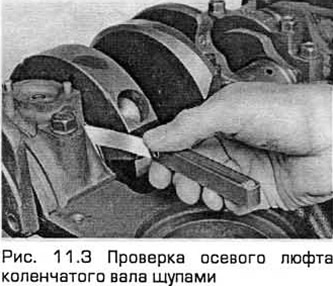Warning: Pay attention to the warning and note. regarding the V-engine in paragraphs 1 and 3.
Note: The crankshaft can only be removed after the power unit has been removed from the vehicle. This assumes that the transmission, as well as the flywheel/faceplate, toothed belt, lower crankcase on models with 4-cylinder engines from 05.1998, cylinder head, sump, intake pipe/oil pump strainer and oil deflector, oil pump, connecting rod piston groups have already been removed. Before removing the crankshaft, the bolts of the left cuff housing must be unscrewed from the cylinder block / crankcase.
1. Before removing the crankshaft, check its end play. Mount the dial indicator perpendicular to the end of the shaft so that its tip touches the end of the shaft (see fig. 11.1).

2. Fully press the shaft away from the indicator and zero the indicator. Then press the shaft against the indicator as far as possible and take the reading. This is the axial clearance. If it is more than acceptable, check for wear on the surfaces of the crankshaft that perceive axial force. If no wear is found, the end play can be corrected by installing new thrust washers. On models with a 4-cylinder engine manufactured from 05.1998, they are made in one piece with the upper main bearing shell No. 3 (see fig. 11.2).

3. If you don't have an indicator, use a feeler gauge. Carefully press the crankshaft towards the right side of the engine. Insert a feeler gauge between the shaft and the right end of the No. 3 main bearing (central) to determine the gap (see fig. 11.3).

4. On models with a 4-cylinder engine, check the main bearing caps: do they have position markings (see fig. 11.4). They should have numbers corresponding to the cylinder numbers. If they are not there, then apply the numbers with a core or a special tool for extruding numbers. The covers must also have an arrow indicating the 8th side of the toothed belt. Paying attention to differences in anchoring (for oil deflector nuts) on covers 2 and 4, loosen the cover bolts a quarter of a turn at a time, starting with the left and right covers towards the middle, until the bolts can be turned out by hand.

5. On V-6 models, the lower crankcase holds the lower main bearing shells and crankshaft in the cylinder block. Conventional main bearing caps are not used on these engines. In addition, the internal bolts of the lower crankcase are disposable and must be replaced with new ones during assembly. Gradually loosen the lower crankcase bolts, then remove them and separate the lower crankcase from the cylinder block. Note the position of the lower main bearing shells.
6. On 4-cylinder models, tap the covers lightly with a soft-faced hammer and separate them from the cylinder block/crankcase. If necessary, press out the covers with bolts. Take care to keep the liners from falling out of the lids if they come off with the lids.
7. Gently lift the crankshaft. It is better to have an assistant help you, as the shaft is quite heavy. Liners and caps of main bearings (4 cylinder engines) or lower crankcase (V-shaped 6-cylinder engines) should be installed in their places in the cylinder block / crankcase, slightly tightening the bolts. This is necessary so as not to accidentally damage the bearing cradles. When installing, you need to use new inserts.
Visitor comments